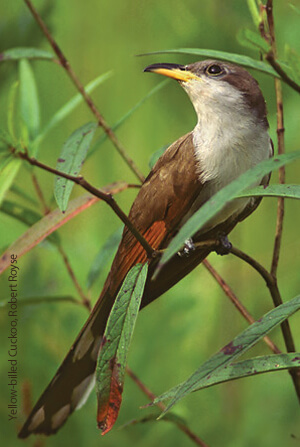Threatened Listing Good News for Western Yellow-billed Cuckoo
 |
|---|
(Washington, D.C., October 2, 2014) American Bird Conservancy (ABC) applauds the U.S. Fish and Wildlife Service (FWS) decision to list the western population of the Yellow-billed Cuckoo as a threatened species under the Endangered Species Act. The listing is expected to bring about the necessary protections for the imperiled bird species whose numbers have plummeted in recent decades.
"The final rule recognizes that current environmental regulations are inadequate to eliminate the threats faced by the western Yellow-billed Cuckoo,” said Steve Holmer, senior policy advisor with American Bird Conservancy. "Federal agencies must take responsibility for the water diversion and grazing policies that are harming the species. Today's listing tells federal managers to chart a new direction and develop a plan to restore riparian areas and regrow lost Yellow-billed Cuckoo habitat.”
In the United States, only 350 to 495 pairs of the bird exist, with a similar number found in Mexico. The birds are isolated in small patches of increasingly degraded riparian forest habitat. The rule notes that these small patches are “in close proximity to human-altered landscapes, especially agriculture fields, resulting in potential for pesticides to poison individual western yellow-billed cuckoos and reduce their prey base.”
The final rule, which will become effective November 3, says that collisions with towers during migration is also a significant threat to the remaining western Yellow-billed Cuckoos. "ABC urges that a program be adopted to educate and provide financial incentives for tower owners within the species' range to adopt modern lighting known to reduce Yellow-billed Cuckoo deaths," said Holmer.
As long-distance, nocturnal migrants, Yellow-billed Cuckoos are vulnerable to collisions with tall buildings, cell towers, radio antennas, wind turbines, and other structures. The cuckoos are known to be attracted to lights that can lead to fatal collisions. An ABC report documenting bird deaths at towers found evidence of a total of 568 Yellow-billed Cuckoo deaths at 17 towers.
Researchers have found that by extinguishing the steady-burning red lights on towers, nighttime bird fatality rates can be reduced by more than 70 percent. Birds are not as likely to be attracted to and collide with towers that are lit with only red flashing lights or white flashing lights. In December 2011, the Federal Communications Commission agreed on interim changes to their system for approving applications for new telecommunication towers.
The species has been extirpated or nearly so from most of its historical range across portions of 12 western states as well as British Columbia. There have been no recent sightings in Oregon, Washington, or Montana. In California, the population is estimated to be less than one percent of its probable historic size. Populations of fewer than 10 pairs exist in Nevada, Wyoming, Colorado, and Texas, and in Idaho and Utah only an estimated 10 to 20 pairs remain.
The extent of the cuckoo's riparian habitat loss is extreme: 90 to 95 percent in Arizona, 90 percent in New Mexico, and 90 to 99 percent in California. In Arizona, the state with largest U.S. cuckoo population, numbers have declined 70 to 80 percent in the past 30 years.
"FWS finds there is ongoing degradation, habitat loss, and pesticide impacts and concludes that these threats are anticipated to continue for decades to come,” said Holmer. "New management standards and regulatory mechanisms to protect and restore the cuckoo's habitat are urgently needed. Today's ESA listing fosters these changes and brings the western Yellow-billed Cuckoo a step closer to recovery."


















































